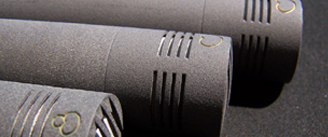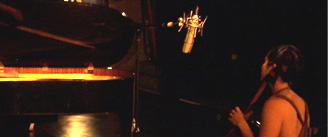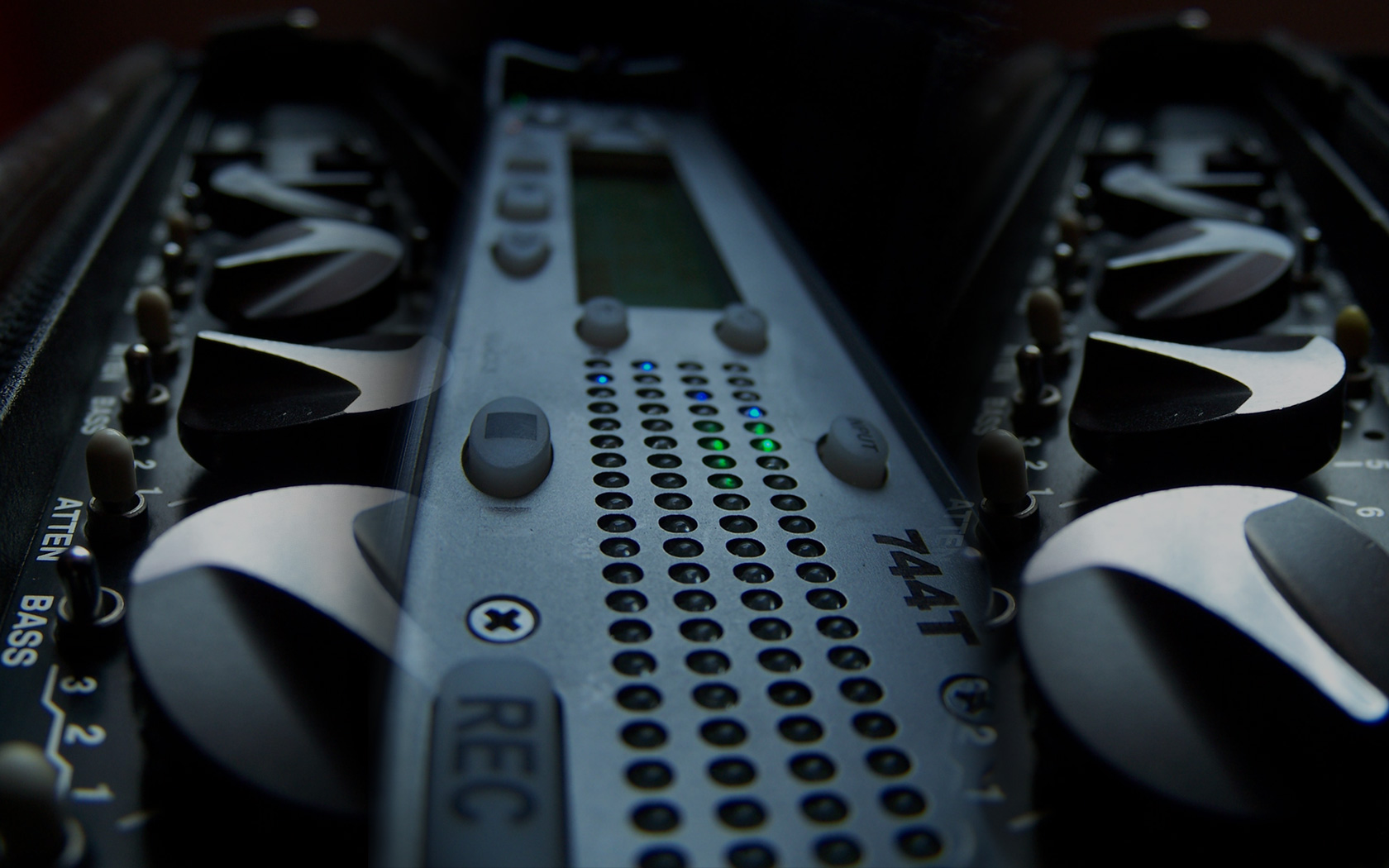

Shooting
- Full sound recording kit for feature film – fiction and documentary
Details
- Digital 16 inputs, 20 tracks audio recorder Sound Devices 888 + SL2
- Digital 4 tracks audio recorder Sound Devices 744T
- Analog mono audio recorder Nagra 4.2
- Portable Mixer SQN 4S 42
- 2 static hypercardio mike Schoeps CMC6 MK41
- 1 static cardioid mike Schoeps CMC6 MK4
- Stereo ORTF system= cardio mikes 2x paired Schoeps MK4
- 2 static cardio mike Elation Mk201
- 1 shotgun mike Sennheiser MKH416
- 1 hypercardio ribbon mike Beyer M160
- 2 hypercardio dynamic mike Beyer M88
- 2 hypercardio dynamic mike Beyer M69
- 1 omni dynamic hand-mike Beyer M58
- 1 omni dynamic hand-mike Sennheiser MD21
- HF radio mike system Wisycom: Rx quad MCR54 + Tx MTP60
- Capsules micro lav Sanken cos11
- Capsules micro lav Countryman EMW
- IFB Sennheiser G3 & Lectrosonics IFB T4 + receivers IFBlue
- 3 Time Code box Tentacle synch BT
- Electronic slate Denecke
- Booms Vdb
- Hearphones Sennheiser HD25
- Hearphones Sony MDR-7506
- Top range cables (Mogami, Belden, Canare, Gotham…)
- Accessories (Cinela, Rycote, Ltm, Manfrotto, K&M etc…)

Mobile studio
- Mobile recording system for acoustic music and/or live performance
- Double stereo recording for acoustic music
- or 24 tracks multitracking (can be extended to 56 tracks)
Details
- 4 Tracks digital recorder Sound Devices 744T
- Mono analog tape recorder Nagra 4.2
- Interfaces firewire MOTU Traveler 1 and MK3
- Laptop PC HP
- Mixer SQN 4S 42
- Preamp stereo Alice customised
- Preamp 8 ch Audient ASP008
- Digital mixing desk Yamaha 01v96i
- 1 condenser mike hypercardio Schoeps CMC6 – MK41
- Stéréo set-up ORTF – capsules cardio 2x Schoeps MK4
- 2 condenser mikes cardio Elation Mk201
- 2 ribbon mikes hypercardio Beyer M160
- 2 dynamic mikes hypercardio Beyer M88
- 2 dynamic mikes hypercardio Beyer M69
- 1 dynamic mike omni à main Beyer M58
- 1 dynamic mike omni à main Sennheiser MD21
- 1 condenser mike canon Sennheiser MKH416
- 1 condenser mike canon Neumann KM81
- Earphone Beyer DT880pro
- Earphones Sennheiser HD25
- Earphones Sony MDR-7506
- Earphones distributor amp
- Professional cables (Mogami, Belden, Canare, Gotham…)
- Accessories (Cinela, Rycote, Ltm, Manfrotto, K&M etc…)
English + french sound vocabulary
What is room tone, ambient sound, wild sound, and buzz track?
Discussion thread “Need vocabulary” at CAS webboard August 2002 http://www.ideabuzz.com/cas/webboard/
Fred Salles
I need to clarify my english vocabulary regarding recording non-sync sound: what are the actual use of:
- room tone
- matching ambient sound
- ambient sound
- wild sound
- buzz track …
How do you call a sound that you record on its own (non-sync) but is going to be used and synced in the scene you just shot ? (like a sound of a glass put on a table, that you managed to avoid during the take by putting a rubber, because of dialogue) (in french: SON SEUL…)
I used these words sometimes when working with english speaking people, but as I never do post, I often had little doubts about using the appropriate word for announcement and report…
Michael
- room tone
The ‘sound of a room’ without any movement or dialogue. Usually used behind dialogue, ADR, to amke the scene appear seamless.
- matching ambient sound
Similar to above…Creating (or recording) presence to match presence from another scene/take.
- ambient sound
Presence
- wild sound
For instance, recording a playground. The sound doesn’t need to be synced, but adds realism to the environment on screen.
- buzz track
Taken from a definition I had lying around… “Film sound is of paramount importance to the flow of a film. When shooting occurs, there is often no background noise with the exception of the dialogue spoken by the performers. A buzz track helps to alleviate any unnatural silences in film. It is a soundtrack that contains low background noises. Buzz track also refers to film that is used to test a projector and make necessary adjustments to the light emission passing from the exciter bulb which stimulates the soundtrack.”
SON SEUL : I believe you are referring tio ‘Foley’..or the creation of sound effects in post production to add into a film later.
I anxiously await the veterans to urge me to make revisions
Mike Hall
This is how I use the words you mention.
Room Tone: a recording of the sound of the room you have just just shot a scene in. Camera is shut down, actors are gone or standing quiet, lights are on and every other background sound is as it was during the scene Room tone is used to create a matching background for new material to be inserted into the track, or to fill holes created in the track by the romoval of the director’s voice or other background noises.
Ambiance: Also known as ambient sound. I use this term in preference to ‘room tone’. It is the background sound of the set wheather interior or exterior. The camera is not operating, the actors stand silent but all else is the same as while the scene was being shot. Purpose is the same as room tone.
Wild Sound: Any sound recorded at any time without a synch reference.
Buzz Track: I have never heard this phrase used.
Ambiance used to be recorded for several minutes, on the theory that any edits would be audible. With the sampling technology of today, I usually record only 15 sec. of steady ambience, more it there are randomly occuring variations that might be recognized.
Carl Warner
While you are absolutely correct about the usual custom of recording room tone with the camera shut down, (I recorded room tone this method for many years), in recent years I wanted the camera running while I recorded room tone.
After all Mike, the reason for room tone is to provide post with a room tone track to cover ADR, so that the location background accoustics and ambiance noise will match the ADR studio accoustics and ambiance noise. Often when the camera is running there is a hint of camera noise picked up by the microphone. By recording room tone with the camera running we more percisely duplicate the actual bg sounds of the origional scene.
Mike Hall
Your are correct, of course, ambience would be better with the camera rolling film. I have never been succesful in convincing the Dir, AD etc. to do it, and assumed everyone rolled with the camera off.
French translation
Wild sound = Son seul
Ambient sound, Ambience, Athmos = Ambiance
Rolling ! Speed ! = ça tourne !
Mark ! = Annonce !
Slate = clap
In frame = dans le champ
Out of frame = hors champ
frame limit = limite cadre
frame per second = image par seconde
Lav, lepel mike = micro cravate
Radio mike = micro HF
Boom = perche
Boom operator = perchman
Re-recording mixer/engineer = mixeur


